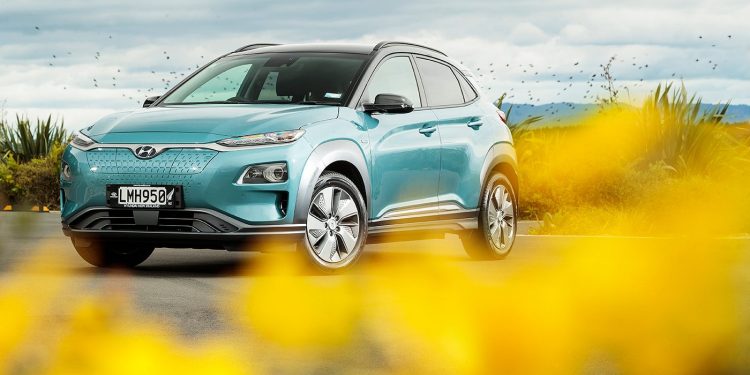2018 Hyundai Kona EV review
Words Kyle Cassidy | Photos Tom Gasnier
It might not be going for speed but the Kona brings genuine touring ability to EV buyers with its range nearly double that of Hyundai’s Ioniq. And it’s an SUV. What’s not to like?
Just a few years ago, Hyundai wasn’t the car company most would have picked to be leading the EV charge here. Okay, there’s Tesla, which is the current market leader YTD with 175 of its Model S and X registered, but Hyundai has moved 163 Ioniqs in 2018, and just launched a second EV model in the Kona. And with a few registered for its arrival, Hyundai is just two units behind Tesla, ready to surpass it by year’s end.
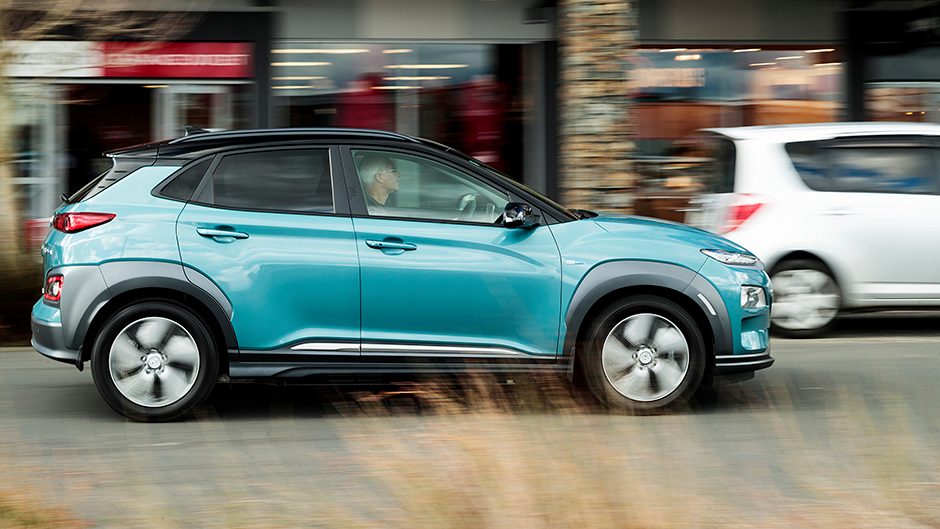
The arrival of the Kona EV shows how quickly this tech can advance. The Ioniq released last year has an 88kW/295Nm motor, a 28kWh battery and a range of 200km. Now the Kona EV comes along with 150kW and 395Nm, energised by a 64kWh battery positioned in the rear subframe under the boot and the rear seats. But the headline number for the Kona EV is the 400km ‘real world’ range. Sure, the price is also pumped up, Ioniq Elite costing $65,990 and the top Kona is $79,990.
Before you get excited, we didn’t undertake an economy run to verify its range to the last kilometre. However, we attended the local launch and all the cars made the 350km journey from Auckland to Raglan and back, some driven to distraction, so it has the goods.
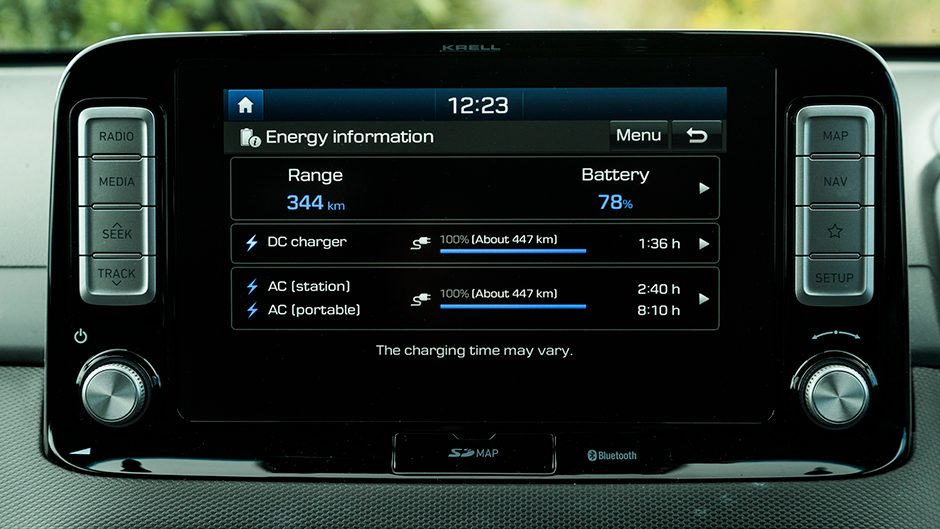
After range, charge times are the next thing people want to know about. Hyundai quotes times (from empty) ranging from 43 hours using the In-Cable Control Box (the one you plug into a regular socket), to 9.5 hours using an AC wall box while a DC fast charge will give 80 per cent in 75 minutes.
Among the many onboard EV menus within the infotainment system is a screen to relay the level of battery charge, and also the estimated time to replenish it fully. For instance, with the battery level at 64 per cent, the system suggested a DC charge would refill it in two hours, the AC Wallbox would take 4hr 20mins and the three-pin plug we were using would require 13hr 40mins. And so it was duly topped up ready for us the next morning.
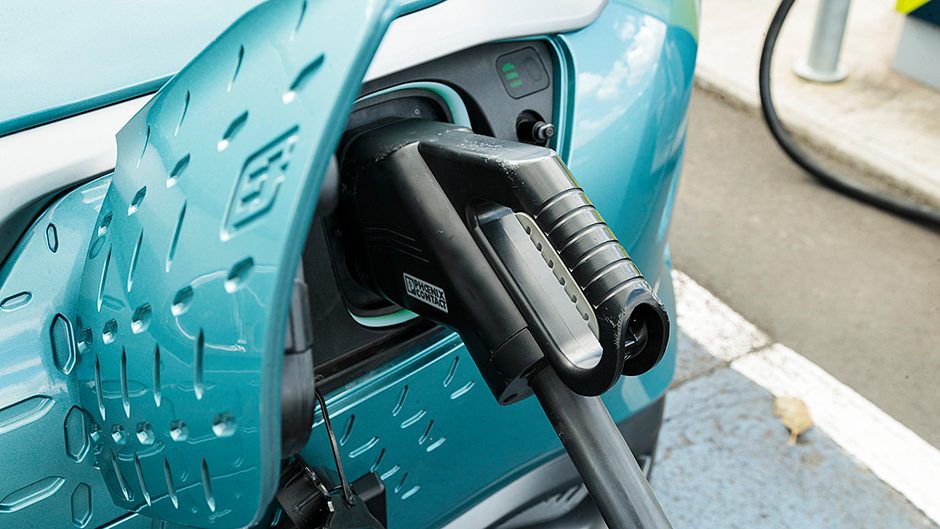
Another menu records a history of the total distance travelled for each day, and during the previous month, this Kona had undertaken a couple of 350km journeys, one in the 200s, a few in the 100s but the rest were in the range of 10 to 80km a day. So the point is, you’d get by, as we did, topping it up every night. And you would be mad not to have the home wallbox installed ($2000) as it’s so convenient to fill at home. There still aren’t enough charge stations for them to be considered user friendly. And do you really want to deal with the EVangelist types that frequent these places? That’s presuming someone isn’t already there, sitting in their docked car reading a paper back. Who has the time?
So the best advice is don’t wait until the battery has run down to near zero. Simply plug in every night at your convenience, and maintain decent range. If you don’t have such a parking arrangement an EV like Kona probably is not the best solution. Unless you like talking/jostling with those aforementioned types at those inconvenient locations. Or paying over the top for power at a Chargenet station. And when you need to travel further than the Kona’s 400km range, it’s probably a better option to fly anyway and use a car sharing scheme when you get there.
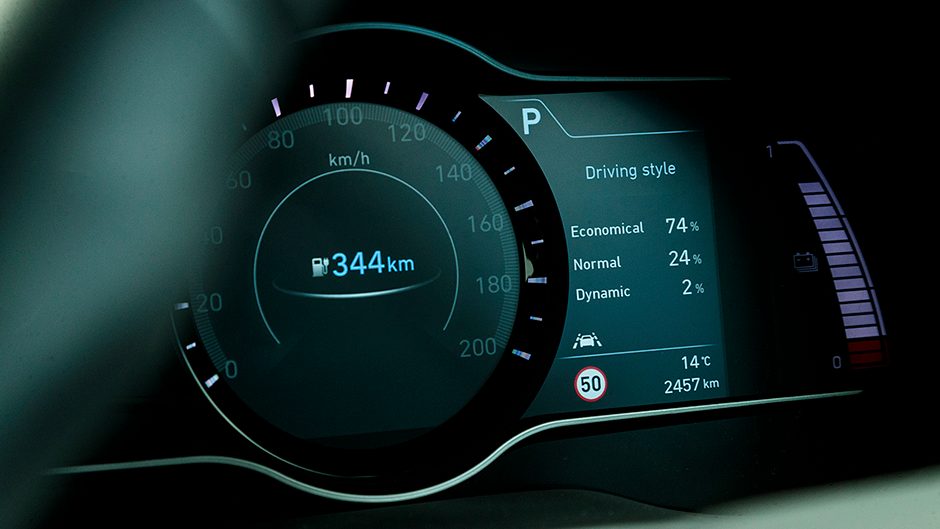
Power usage is quoted at 14.3kWh/100km, which happens to be what the trip computer reckoned we achieved over 500km. Some trips were better than others, one little outing juiced 19kWh/100km, while some were down in the 10kWh area so, as always, your mileage may vary.
Kona has three drive modes, Comfort being the default where it delivers the atypical torquey drive EVs are renowned for. The take-up of power is quick and refined, there are no jolts or shocks through the ‘powertrain’, and it’s super-refined for commuting. It’s also suitably nippy up to 80km/h with extra bouts of pace delivered quickly, seamlessly, smoothly, quietly. Most will buy this as an urban runabout, and it works best in the grinder of city traffic. The ride is suited to urban streets where it sorts sharp bumps efficiently and handles speed bumps too. It’s got that added height for ease of entry and vision in congestion while its compact dimensions and easy steering see it manoeuvred about readily. Why, even the brakes don’t exhibit any uncouth snatching at slow speeds.
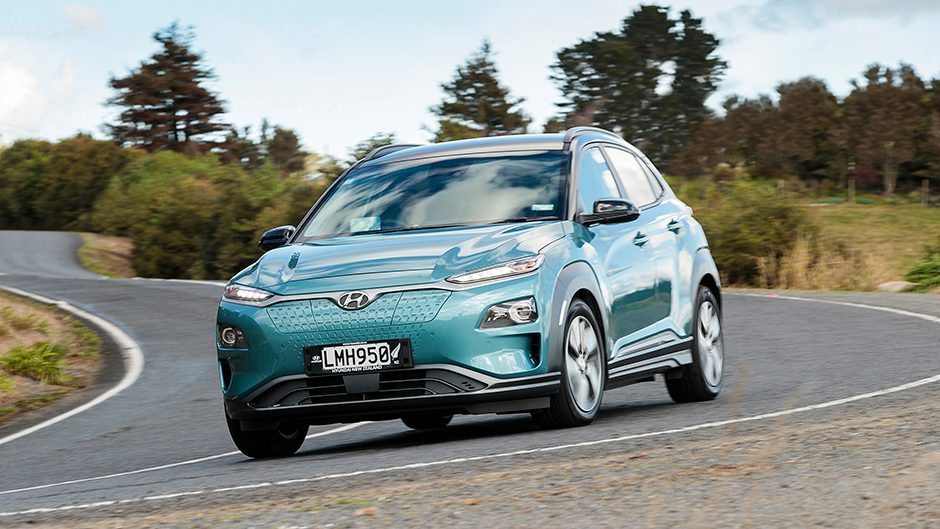
An aspect Hyundai has evolved is the regenerative nature of the braking when you lift off the go pedal. This sees the level of regen altering automatically as the system sees fit. It seems Hyundai has programmed this to maximise range with your typical driver in mind (those who aren’t paying much attention to the traffic flow up ahead) but the way it alters the level of regen can make the slowing process jerky. When the regen is set at level two or three (the max), every time you get off the go pedal, you’re suddenly slowing.
And so to maintain a constant speed you’re having to keep the power on. We like that you can still reduce that regenerative effect, even remove it completely using the steering wheel paddles so that you can coast along when the conditions are right. These EVs can really roll as there is much less driveline friction and they are so heavy that they just keep going. And by way of those paddles, you can reintroduce regen braking on the downhills or when you need to slow for an intersection to the point you hardly need to use the actual brake pedal.
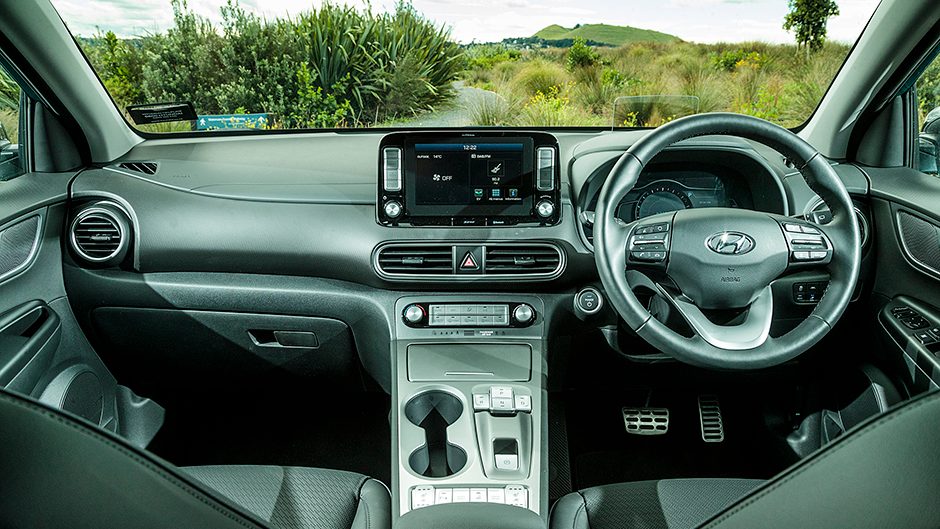
The Eco mode neuters the power and the regen is set high, so we didn’t much like that one while Sport mode was, shall we say, interesting. It’s pretty nippy when the dials turn red, and it doesn’t take much to send the ESP into a fit trying to contain the flow of Newtons. The go pedal is much more responsive, the delivery more abrupt and it chirps the wheels at will in the dry. This would be troublesome on a wet day. While it’s the most powerful Kona, it’s also the heaviest, and that takes its toll on outright performance, especially once the motor has exhausted its torque. It’s slightly quicker than the 1.6 turbo to 100, but is a smidge behind over 80km/h to 120, the run taking five sec.
The steering has no weird weighting characteristics but neither does it have much feel, probably a result of trying to quell the torque influence on the front wheels. It does turn in a tidy fashion as the weight is evenly split, and lies low. However, it doesn’t take much of a serve to get this Kona squirming about as the suspension struggles to contain the considerable weight when it’s pushed around.
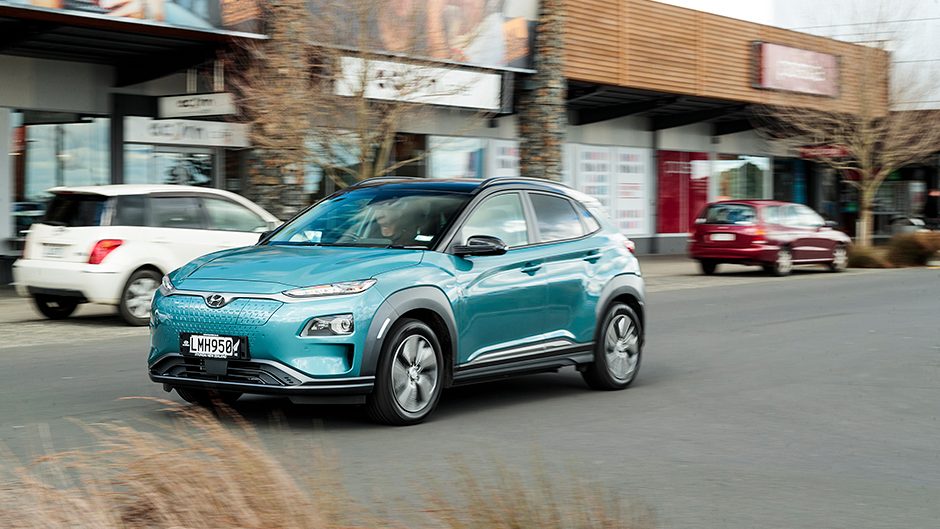
This handles more rigorous outings better than Ioniq which was fairly wayward thanks to its rear torsion beam, where this feels more composed. And faster too with more urgent power delivery. Actually the torque hit in Sport mode can be a bit much, the traction control working hard if you’re too quick and heavy with the volts. This will upset the front end, and so you need to tread carefully to keep progress smooth. Or just keep Kona locked in Comfort mode, where the power delivery feels more in tune with the chassis.
Hyundai has wisely kept the look fairly normal here, just the grille and alloy wheel treatment are different. The interior is otherwise conventional, save for the instrument panel, and the gear lever has been replaced by drive buttons. There are two trim levels offered, each with Hyundai’s SmartSense active safety tech, while the Elite adds niceties like a charge pad, leather, a larger touch screen and Krell audio.
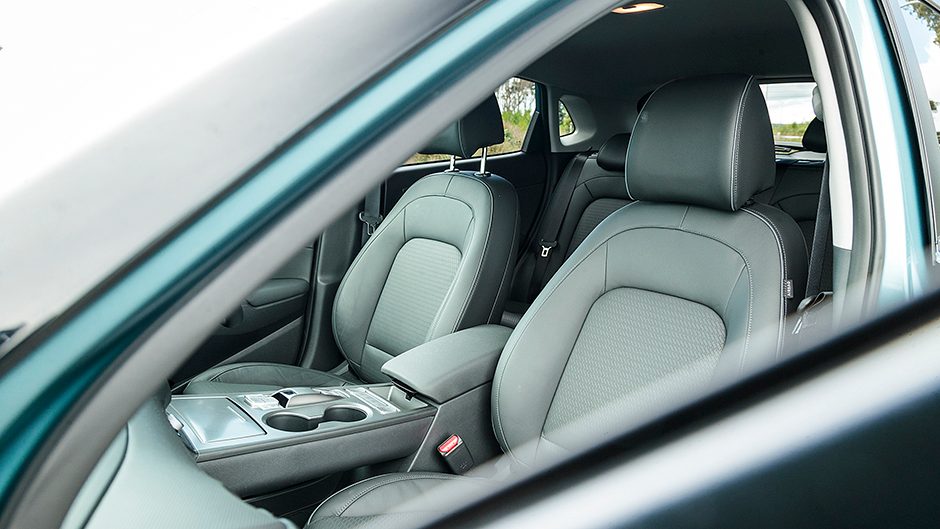
There’s quite a bit of hard plastic in the cabin but the heated and ventilated leather-clad seats are comfy, there’s a smart key and while there’s no in-built nav, it accepts both phone types and there’s all-speed cruise.
The boot capacity of 332L is only 30 less than the conventional Kona’s and you can split fold the rear seat to extend this further. Kona EV is not rated for towing however. There’s a three-year/100,000km vehicle warranty while the battery carries 10-year/unlimited kay cover.
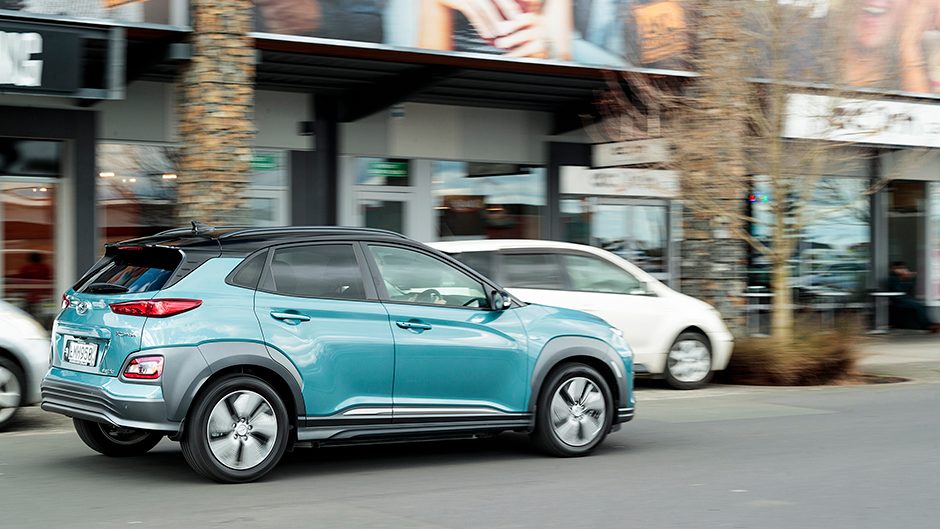
If you’re a private buyer, we’re still a bit reluctant to say this is the bee’s knees due to the price. But those early adopters with cash to spend will not be disappointed and the range is more than most will need.
| Model | Hyundai Kona EV |
| Price | $79,990 |
| Motor/Battery | 150kW/395Nm/64kWh |
| Drivetrain | auto, front-wheel drive |
| Consumption | 14.3kWh/100km |
| C02 Output | 0g/km |
| 0-100km/h | 7.51sec |
| Weight | 1724kg |


